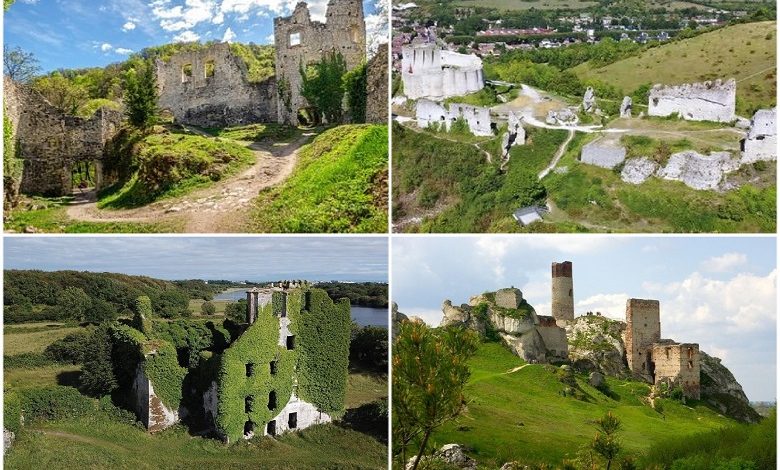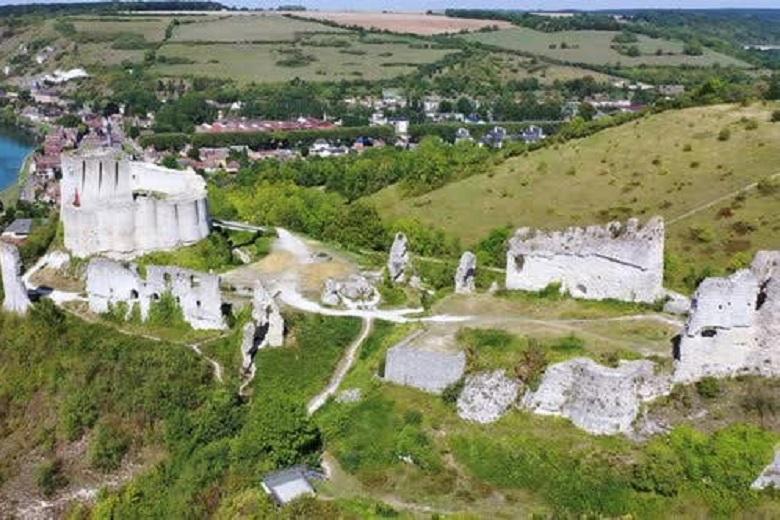Top 5 European magnificent medieval castles that fell into ruins

After many centuries of decline, wars, and historical reconciliation, most of the palaces have turned into disrepair, and now they are only a pale shadow of their former glory. What did they look like during their heyday?
Designers and architects have digitally and animatedly recreated the five most fantastic abandoned castles in Europe, returning them to their former splendor and beauty. We are deprived of the opportunity to travel during the quarantine, but no one canceled the virtual exploration, right? Therefore, we will go on a fascinating journey through the most magnificent European castles, which keep centuries of vibrant history in their ruins.
1. Samobor Castle, Samobor, Croatia

Monarchs ruled the medieval Bohemian kingdom. This kingdom included the territories of the modern Czech Republic and Germany. The period of Bohemia’s existence lasted from the end of the 12th century until the First World War. Samobor Castle was built by the Czech ruler Ottakar ll in the middle of the 13th century. At that time, there was a war for the controversial Duchy of Styria. In the end, Ottakar lost to the Croatian-Hungarian army.
The stone ruins of a once imposing stone citadel rise above the modern city of Samobor. The castle is just ten minutes walk from it. Tourists have something to admire there. The walls of the fortress and the remains of the moat still retain the echoes of the memory of the former power. The watchtower is the only original element that has survived relatively intact—most of the remains, including the Gothic chapel of St. Anne, date from 16th-century modifications.
2. Chateau Gaillard, Les Andelys, France

Chateau Gaillard is one of the first examples of the use of concentric fortifications and loopholes in castle design. The loopholes in the castle walls allowed the defenders of the fortress to pour boiling oil on the attackers and throw stones. This concentric fortification was formed of three defensive walls, one within the other, each separated by a deep moat.
Richard the Lionheart built Gaillard quite quickly, between 1196 and 1198. The fortress was built to protect against the troops of King Philip II of France. The castle has seen a lot in its lifetime before finally being abandoned in the 16th century and later almost destroyed by King Henry IV of France. Nevertheless, something remains of the castle, and this unique structure can still be admired.
3. Menlo Castle, Galway, Ireland

Menlo Castle was owned by the Blake family for most of its existence and was destroyed by fire in 1910. The family’s coachman, James Kirwan, escaped the fire by walking down ivy vines from his window. He tried to save the other residents of the mansion, but he failed. Since then, the castle has been entwined with ivy, and it has become wholly abandoned.
Menlo looks like a mysterious fairytale castle. Thoroughly entwined with ivy, it blends into the natural landscape of the surrounding forests and fields. Unfortunately, it is not known when the castle was built, but it was primarily a house, not a military fortress. Large round towers and a former pier with a cannon ensured the safety of the castle’s inhabitants.
4. Olsztyn Castle, Olsztyn, Poland

Olsztyn Castle is located on a steep hill among limestone cliffs in northeastern Poland. From its windows, a fantastic view of Lyna River opened up. The castle was built around 1306. It was rebuilt by Casimir the Great between 1349-1359 to defend against the Czechs. Olsztyn later became the seat of a military garrison and was reconstructed in the Renaissance style in the 16th century.
At that time, it was a three-level structure with access bridges and a moat. During the wars that followed after the 16th century, the castle gradually suffered significant damage until it was almost destroyed. Today, visitors can still see the original Gothic tower and wander around the fortress, which combines built-in elements with rocks and karst caves.
Poenari Castle, Wallachia, Romania

The legendary Poenari Castle is so decorated with various inspiring details that it seems like it descended from the pages of some fairy tale about princesses and dragons. It once belonged to Vlad lll the Impaler, the governor (duke) of Wallachia, who inspired Bram Stoker to write his famous novel about Count Dracula.
Climbing a concrete staircase of 1,480 steps to a fortress-like eagle’s nest creates an indescribable sense of loneliness and isolation in this castle on the rock. It is easy to feel dizzy at this altitude, especially when you consider that a landslide partially destroyed the castle. Because of this, the castle sank as much as 400 meters below the river.
Poenari Castle was built in a very intricate way. At one time, the owner himself, Vlad Impaler, escaped death by fleeing from the warriors besieging the castle through a secret passage to the Carpathians. The fortress was fortified with earth and lime; later, the governor built additional towers to protect the court. Now the castle is closed to visitors because bears are walking around there. The authorities plan to solve this problem shortly and build a cable car to make it easier for tourists to climb out of the valley.




